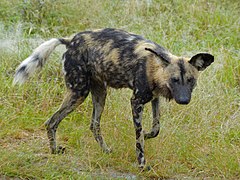Likaon (rodzaj ssaków)
| Lycaon | |||
| Brookes, 1827[1] | |||
 Przedstawiciel rodzaju – likaon pstry (L. pictus) | |||
| Systematyka | |||
| Domena | |||
|---|---|---|---|
| Królestwo | |||
| Typ | |||
| Podtyp | |||
| Gromada | |||
| Podgromada | |||
| Infragromada | |||
| Rząd | |||
| Podrząd | |||
| Infrarząd | |||
| Rodzina | |||
| Rodzaj |
likaon | ||
| Typ nomenklatoryczny | |||
|
Lycaon tricolor Brookes, 1827 (= Hyaena picta Temminck, 1820) | |||
| Synonimy | |||
|
| |||
| Gatunki | |||
| |||
Likaon[6] (Lycaon) – rodzaj ssaków z rodziny psowatych (Canidae).
Zasięg występowania
[edytuj | edytuj kod]Rodzaj obejmuje jeden współcześnie żyjący gatunek występujący w Afryce[7][8][9].
Morfologia
[edytuj | edytuj kod]Długość ciała samic 93–141 cm, samców 84,5–138,5 cm, długość ogona samic 31–37 cm, samców 32–42 cm; masa ciała samic 18–26,5 kg, samców 21–34,5 kg[8][10].
Systematyka
[edytuj | edytuj kod]Rodzaj zdefiniował w 1827 roku brytyjski przyrodnik Joshua Brookes w rozdziale dotyczącym systematyki ssaków w publikacji pod redakcją Cuviera i Griffitha poświęconej królestwu zwierząt[1]. Na gatunek typowy wyznaczył (oznaczenie monotypowe) likaona pstrego (L. pictus).
- Lycaon: gr. λυκος lukos ‘wilk’; κυων kuōn, κυνος kunos ‘pies’[11]
- Cynhyaena: gr. κυων kuōn, κυνος kunos ‘pies’; ύαινα huaina ‘hiena’[12]. Gatunek typowy (oznaczenie monotypowe): Hyaena picta Temminck, 1820.
- Hyenoides (Hyaenoides): rodzaj Hyaena Brisson, 1762 (hiena); -οιδης -oidēs ‘przypominający’[13]. Gatunek typowy (oznaczenie monotypowe): Hyaena picta Temminck, 1820.
- Kynos: gr. κυων kuōn, κυνος kunos ‘pies’[14]. Gatunek typowy (oznaczenie monotypowe): Hyaena picta Temminck, 1820.
Podział systematyczny
[edytuj | edytuj kod]Do rodzaju należy jeden współcześnie występujący gatunek[15][10][7][6]:
- Lycaon pictus (Temminck, 1820) – likaon pstry
Opisano również gatunki wymarłe:
- Lycaon magnus Ewer & Singer, 1956[16] (Afryka; plejstocen).
- Lycaon sekowei Hartstone-Rose, Werdelin, Ruiter, Berger & Churchill, 2010[17] (Afryka; pliocen–plejstocen).
Przypisy
[edytuj | edytuj kod]- ↑ a b J. Brookes: A synopsis of the species of the class Mammalia. W: F. Cuvier & E. Griffith: The animal kingdom: arranged in conformity with its organization. Cz. 5. London: Printed for G.B. Whittaker, 1827, s. 151. (ang.).
- ↑ F. Cuvier: Zoologie = Mammalogie. W: Dictionnaire des sciences naturelles, dans lequel on traite méthodiquement des différens êtres de la nature, considérés soit en eux-mêmes, d’après l’état actuel de nos connoissances, soit relativement à l’utilité qu'en peuvent retirer la médecine, l’agriculture, le commerce et les artes. Suivi d’une biographie des plus célèbres naturalistes. T. 59. Paris & Strasbourg: F. G. Levrault & Le Normant, 1829, s. 454. (fr.).
- ↑ P. Boitard: Le Jardin des plantes: description et murs des mammifères de la Ménagerie et du Muséum d’histoire naturelle. Paris: J.J. Dubochet et Ce, Éditeurs, 1842, s. 215. (fr.).
- ↑ E. Rüppell. Verzeichniss der in dem Museum der Senckenbergischen naturforschenden Gesellschaft aufgestellten Sammlungen. Erste Abtheilung: Säugethiere und deren Skelette. „Museum Senckenbergianum: Abhandlungen aus dem Gebiete der beschreibenden Naturgeschichte”. 3 (2), s. 163, 1845. (niem.).
- ↑ P. Gervais: Histoire naturelle des mammifères avec l’indication de leurs moeurs et de leurs rapports avec les arts, le commerce et l’agriculture. Paris: L. Curmer, 1855, s. 53. (fr.).
- ↑ a b W. Cichocki, A. Ważna, J. Cichocki, E. Rajska-Jurgiel, A. Jasiński, W. Bogdanowicz: Polskie nazewnictwo ssaków świata. Warszawa: Muzeum i Instytut Zoologii PAN, 2015, s. 149. ISBN 978-83-88147-15-9. (pol. • ang.).
- ↑ a b C.J. Burgin, D.E. Wilson, R.A. Mittermeier, A.B. Rylands, T.E. Lacher & W. Sechrest: Illustrated Checklist of the Mammals of the World. Cz. 2: Eulipotyphla to Carnivora. Barcelona: Lynx Edicions, 2020, s. 430. ISBN 978-84-16728-35-0. (ang.).
- ↑ a b C. Sillero-Zubiri: Family Canidae (Dogs). W: D.E. Wilson, R.A. Mittermeier (redaktorzy): Handbook of the Mammals of the World. Cz. 1: Carnivores. Barcelona: Lynx Edicions, 2009, s. 424. ISBN 978-84-96553-49-1. (ang.).
- ↑ D.E. Wilson & D.M. Reeder (redaktorzy): Genus Lycaon. [w:] Mammal Species of the World. A Taxonomic and Geographic Reference (Wyd. 3) [on-line]. Johns Hopkins University Press, 2005. [dostęp 2021-05-18]. (ang.).
- ↑ a b Class Mammalia. W: Lynx Nature Books: All the Mammals of the World. Barcelona: Lynx Edicions, 2023, s. 667. ISBN 978-84-16728-66-4. (ang.).
- ↑ Palmer 1904 ↓, s. 389.
- ↑ Palmer 1904 ↓, s. 209.
- ↑ Palmer 1904 ↓, s. 337.
- ↑ Palmer 1904 ↓, s. 359.
- ↑ N. Upham, C. Burgin, J. Widness, M. Becker, C. Parker, S. Liphardt, I. Rochon & D. Huckaby: Treeview of Mammalian Taxonomy Hierarchy. [w:] ASM Mammal Diversity Database (Version 1.11) [on-line]. American Society of Mammalogists. [dostęp 2023-12-16]. (ang.).
- ↑ R.F. Ewer & R. Singer. Fossil Carnivora from Hopefield. „Annals of the South African Museum”. 42 (4), s. 340, 1956. (ang.).
- ↑ A. Hartstone-Rose, L. Werdelin, D.J. De Ruiter, L.R. Berger & S.E. Churchill. The Plio-Pleistocene ancestor of wild dogs, Lycaon sekowei n. sp. „Journal of Paleontology”. 84 (2), s. 299-308, 2010. DOI: 10.1666/09-124.1. (ang.).
Bibliografia
[edytuj | edytuj kod]- T.S. Palmer. Index Generum Mammalium: a List of the Genera and Families of Mammals. „North American Fauna”. 23, s. 1–984, 1904. (ang.).
